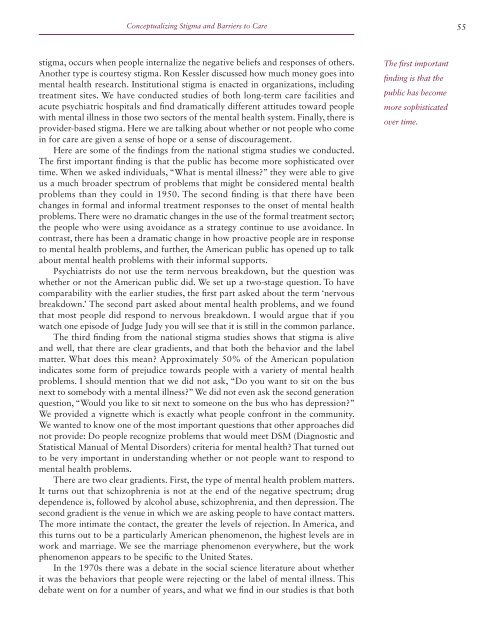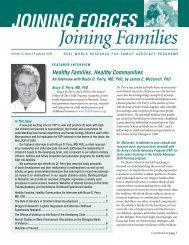stigma and barriers to care - Uniformed Services University of the ...
stigma and barriers to care - Uniformed Services University of the ...
stigma and barriers to care - Uniformed Services University of the ...
You also want an ePaper? Increase the reach of your titles
YUMPU automatically turns print PDFs into web optimized ePapers that Google loves.
Conceptualizing Stigma <strong>and</strong> Barriers <strong>to</strong> Care 55<br />
<strong>stigma</strong>, occurs when people internalize <strong>the</strong> negative beliefs <strong>and</strong> responses <strong>of</strong> o<strong>the</strong>rs.<br />
Ano<strong>the</strong>r type is courtesy <strong>stigma</strong>. Ron Kessler discussed how much money goes in<strong>to</strong><br />
mental health research. Institutional <strong>stigma</strong> is enacted in organizations, including<br />
treatment sites. We have conducted studies <strong>of</strong> both long-term <strong>care</strong> facilities <strong>and</strong><br />
acute psychiatric hospitals <strong>and</strong> find dramatically different attitudes <strong>to</strong>ward people<br />
with mental illness in those two sec<strong>to</strong>rs <strong>of</strong> <strong>the</strong> mental health system. Finally, <strong>the</strong>re is<br />
provider-based <strong>stigma</strong>. Here we are talking about whe<strong>the</strong>r or not people who come<br />
in for <strong>care</strong> are given a sense <strong>of</strong> hope or a sense <strong>of</strong> discouragement.<br />
Here are some <strong>of</strong> <strong>the</strong> findings from <strong>the</strong> national <strong>stigma</strong> studies we conducted.<br />
The first important finding is that <strong>the</strong> public has become more sophisticated over<br />
time. When we asked individuals, “What is mental illness” <strong>the</strong>y were able <strong>to</strong> give<br />
us a much broader spectrum <strong>of</strong> problems that might be considered mental health<br />
problems than <strong>the</strong>y could in 1950. The second finding is that <strong>the</strong>re have been<br />
changes in formal <strong>and</strong> informal treatment responses <strong>to</strong> <strong>the</strong> onset <strong>of</strong> mental health<br />
problems. There were no dramatic changes in <strong>the</strong> use <strong>of</strong> <strong>the</strong> formal treatment sec<strong>to</strong>r;<br />
<strong>the</strong> people who were using avoidance as a strategy continue <strong>to</strong> use avoidance. In<br />
contrast, <strong>the</strong>re has been a dramatic change in how proactive people are in response<br />
<strong>to</strong> mental health problems, <strong>and</strong> fur<strong>the</strong>r, <strong>the</strong> American public has opened up <strong>to</strong> talk<br />
about mental health problems with <strong>the</strong>ir informal supports.<br />
Psychiatrists do not use <strong>the</strong> term nervous breakdown, but <strong>the</strong> question was<br />
whe<strong>the</strong>r or not <strong>the</strong> American public did. We set up a two-stage question. To have<br />
comparability with <strong>the</strong> earlier studies, <strong>the</strong> first part asked about <strong>the</strong> term ‘nervous<br />
breakdown.’ The second part asked about mental health problems, <strong>and</strong> we found<br />
that most people did respond <strong>to</strong> nervous breakdown. I would argue that if you<br />
watch one episode <strong>of</strong> Judge Judy you will see that it is still in <strong>the</strong> common parlance.<br />
The third finding from <strong>the</strong> national <strong>stigma</strong> studies shows that <strong>stigma</strong> is alive<br />
<strong>and</strong> well, that <strong>the</strong>re are clear gradients, <strong>and</strong> that both <strong>the</strong> behavior <strong>and</strong> <strong>the</strong> label<br />
matter. What does this mean Approximately 50% <strong>of</strong> <strong>the</strong> American population<br />
indicates some form <strong>of</strong> prejudice <strong>to</strong>wards people with a variety <strong>of</strong> mental health<br />
problems. I should mention that we did not ask, “Do you want <strong>to</strong> sit on <strong>the</strong> bus<br />
next <strong>to</strong> somebody with a mental illness” We did not even ask <strong>the</strong> second generation<br />
question, “Would you like <strong>to</strong> sit next <strong>to</strong> someone on <strong>the</strong> bus who has depression”<br />
We provided a vignette which is exactly what people confront in <strong>the</strong> community.<br />
We wanted <strong>to</strong> know one <strong>of</strong> <strong>the</strong> most important questions that o<strong>the</strong>r approaches did<br />
not provide: Do people recognize problems that would meet DSM (Diagnostic <strong>and</strong><br />
Statistical Manual <strong>of</strong> Mental Disorders) criteria for mental health That turned out<br />
<strong>to</strong> be very important in underst<strong>and</strong>ing whe<strong>the</strong>r or not people want <strong>to</strong> respond <strong>to</strong><br />
mental health problems.<br />
There are two clear gradients. First, <strong>the</strong> type <strong>of</strong> mental health problem matters.<br />
It turns out that schizophrenia is not at <strong>the</strong> end <strong>of</strong> <strong>the</strong> negative spectrum; drug<br />
dependence is, followed by alcohol abuse, schizophrenia, <strong>and</strong> <strong>the</strong>n depression. The<br />
second gradient is <strong>the</strong> venue in which we are asking people <strong>to</strong> have contact matters.<br />
The more intimate <strong>the</strong> contact, <strong>the</strong> greater <strong>the</strong> levels <strong>of</strong> rejection. In America, <strong>and</strong><br />
this turns out <strong>to</strong> be a particularly American phenomenon, <strong>the</strong> highest levels are in<br />
work <strong>and</strong> marriage. We see <strong>the</strong> marriage phenomenon everywhere, but <strong>the</strong> work<br />
phenomenon appears <strong>to</strong> be specific <strong>to</strong> <strong>the</strong> United States.<br />
In <strong>the</strong> 1970s <strong>the</strong>re was a debate in <strong>the</strong> social science literature about whe<strong>the</strong>r<br />
it was <strong>the</strong> behaviors that people were rejecting or <strong>the</strong> label <strong>of</strong> mental illness. This<br />
debate went on for a number <strong>of</strong> years, <strong>and</strong> what we find in our studies is that both<br />
The first important<br />
finding is that <strong>the</strong><br />
public has become<br />
more sophisticated<br />
over time.




